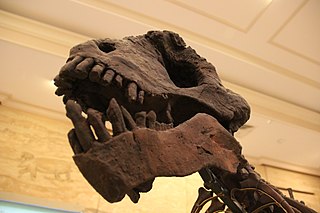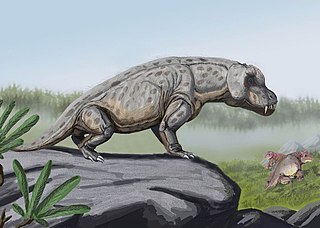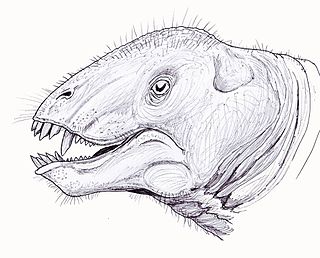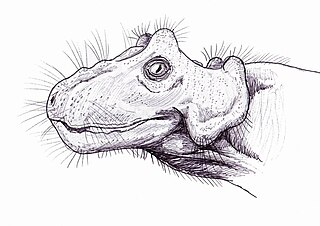Dinosaurus is an extinct genus of therapsid of controversial affinities. Its type and only species is Dinosaurus murchisonii. It is only known from a partial snout from the Permian of Russia. Its taxonomic history is intertwined with several other poorly-known Russian therapsids, particularly Rhopalodon, Brithopus, and Phthinosuchus.

Deuterosaurus is an extinct genus of dinocephalian therapsids, one of the non-mammalian synapsids dominating the land during the late Paleozoic.

Eotitanosuchus is an extinct genus of biarmosuchian therapsids whose fossils were found in the town of Ochyor in Perm Krai, Russia. It lived about 267 million years ago. The only species is Eotitanosuchus olsoni.

Jonkeria is an extinct genus of dinocephalians. Jonkeria was a large and omnivorous animal, from the Tapinocephalus Assemblage Zone, Lower Beaufort Group, of the South African Karoo.

Inostrancevia is an extinct genus of large carnivorous therapsids which lived during the Late Permian in what is now European Russia and Southern Africa. The first-known fossils of this gorgonopsian were discovered in the Northern Dvina, where two almost complete skeletons were exhumed. Subsequently, several other fossil materials were discovered in various oblasts, and these finds will lead to a confusion about the exact number of valid species in the country, before only three of them were officially recognized: I. alexandri, I. latifrons and I. uralensis. More recent research carried out in South Africa has discovered fairly well-preserved remains of the genus, being attributed to the species I. africana. An isolated left premaxilla suggests that Inostrancevia also lived in Tanzania during the earliest Lopingian age. The whole genus is named in honor of Alexander Inostrantsev, professor of Vladimir P. Amalitsky, the paleontologist who described the taxon.

Ulemosaurus is an extinct genus of dinocephalian therapsids that lived 265 to 260 million years ago, at Isheevo in Russian Tatarstan. It was a tapinocephalid, a group of bulky herbivores which flourished in the Middle Permian. Ulemosaurus and other tapinocephalians disappeared at the end of the Middle Permian.

Anteosaurs are a group of large, primitive carnivorous dinocephalian therapsids with large canines and incisors and short limbs, that are known from the Middle Permian of South Africa, Russia, China, and Brazil. Some grew very large, with skulls 50–80 centimetres (20–31 in) long, and were the largest predators of their time. They died out at the end of the Middle Permian, possibly as a result of the extinction of the herbivorous Tapinocephalia on which they may have fed.

Anteosaurus is an extinct genus of large carnivorous dinocephalian synapsid. It lived at the end of the Guadalupian during the Capitanian stage, about 265 to 260 million years ago in what is now South Africa. It is mainly known by cranial remains and few postcranial bones. Measuring 5–6 m (16–20 ft) long and weighing about 600 kg (1,300 lb), Anteosaurus was the largest known carnivorous non-mammalian synapsid and the largest terrestrial predator of the Permian period. Occupying the top of the food chain in the Middle Permian, its skull, jaws and teeth show adaptations to capture large prey like the giants titanosuchids and tapinocephalids dinocephalians and large pareiasaurs.

Struthiocephalus is an extinct genus of dinocephalian therapsids from the Permian of South Africa. It was a large animal, reaching 288 kg (635 lb) in body mass.

Tapinocaninus is an extinct genus of therapsids in the family Tapinocephalidae, of which it is the most basal member. Only one species is known, Tapinocaninus pamelae. The species is named in honor of Rubidge's mother, Pam. Fossils have been found dating from the Middle Permian.

Styracocephalus platyrhynchus is an extinct genus of dinocephalian therapsid that existed during the mid-Permian throughout South Africa, but mainly in the Karoo Basin. It is often referred to by its single known species Styracocephalus platyrhynchus. The Dinocephalia clade consisted of the largest land vertebrates and herbivores during the early to mid-Permian. This period is often also referred to as the Guadalupian epoch, approximately 270 to 260 million years ago.

Venyukovia is an extinct genus of venyukovioid therapsid, a basal anomodont from the Middle Permian of Russia. The type and sole species, V. prima, is known only by a partial lower jaw with teeth. Venyukovia has often been incorrectly spelt as 'Venjukovia' in English literature. This stems from a spelling error made by Russian palaeontologist Ivan Efremov in 1940, who mistakenly replaced the 'y' with a 'j', which subsequently permeated through therapsid literature before the mistake was caught and corrected. Venyukovia is the namesake for the Venyukovioidea, a group of small Russian basal anomodonts also including the closely related Otsheria, Suminia, Parasuminia and Ulemica, although it itself is also one of the poorest known. Like other venyukovioids, it had large projecting incisor-like teeth at the front and lacked canines, although the remaining teeth are simple compared to some other venyukovioids, but may resemble those of Otsheria.

Paraburnetia is an extinct genus of biarmosuchian therapsids from the Late Permian of South Africa. It is known for its species P. sneeubergensis and belongs to the family Burnetiidae. Paraburnetia lived just before the Permian–Triassic mass extinction event.
Eurosaurus is an extinct genus of non-mammalian synapsids. Its taxonomic history is intertwined with that of the therapsids Brithopus and Orthopus and the temnospondyl Melosaurus.

Niaftasuchus is an extinct genus of therapsids. Its type and only named species is Niaftasuchus zekkeli.

Criocephalosaurus is an extinct genus of tapinocephalian therapsids that lived in Southern Africa during the Guadalupian epoch of the Permian. They are the latest surviving dinocephalians, extending past the Abrahamskraal Formation into the lowermost Poortjie Member of the Teekloof Formation in South Africa. They are also regarded as the most derived of the dinocephalians, alongside Tapinocephalus, and the most abundant in the fossil record.

Akidnognathidae is an extinct family of therocephalian therapsids from the Late Permian and Early Triassic of South Africa, Russia and China. The family includes many large-bodied therocephalians that were probably carnivorous, including Moschorhinus and Olivierosuchus. One akidnognathid, Euchambersia, may even have been venomous. Akidnognathids have robust skulls with a pair of large caniniform teeth in their upper jaws. The family is morphologically intermediate between the more basal therocephalian group Scylacosauridae and the more derived group Baurioidea.

Venyukovioidea is an infraorder of anomodont therapsids related to dicynodonts from the Permian of Russia. They have also been known as 'Venjukovioidea', as well as by the similar names 'Venyukoviamorpha' or 'Venjukoviamorpha' in literature. This in part owes to a misspelling by Russian palaeontologist Ivan Efremov in 1940 when he mistakenly spelt Venyukovia, the namesake of the group, with a 'j' instead of a 'y', which permeated through subsequent therapsid literature before the mistake was caught and corrected. The order Ulemicia has also been coined for a similar taxonomic concept in Russian scientific literature, which notably excludes Suminia and Parasuminia.

Sinophoneus is an extinct genus of carnivorous dinocephalian therapsid belonging to the family Anteosauridae. It lived 272 to 270 million years ago at the beginning of the Middle Permian in what is now the Gansu Province in northern China. It is known by a skull of an adult individual, as well as by many skulls of juvenile specimens. The latter were first considered as belonging to a different animal, named Stenocybus, before being reinterpreted as immature Sinophoneus. Sinophoneus shows a combination of characters present in other anteosaurs. Its bulbous profile snout and external nostrils located in front of the canine are reminiscent of the basal anteosaur Archaeosyodon, while its massive transverse pterygoids processes with enlarged distal ends are more similar to the more derived anteosaurs Anteosaurus and Titanophoneus. First phylogenetic analyzes identified Sinophoneus as the most basal Anteosaurinae. A more recent analysis positioned it outside the Anteosaurinae and Syodontinae subclades, and recovers it as the most basal Anteosauridae.
Parasumina is an extinct genus of anomodont known from the late Capitanian age at the end of the middle Permian period of European Russia. The type and only species is Parasuminia ivakhnenkoi. It was closely related to Suminia, another Russian anomodont, and was named for its resemblance. Little is known about Parasuminia as the only fossils are of fragmentary pieces of the skull and jaw, but the known remains suggest that its head and jaws were deeper and more robust than those of Suminia, and with shorter, stouter teeth. However, despite these differences they appear to have been similar animals with a similarly complex method of processing vegetation.





















